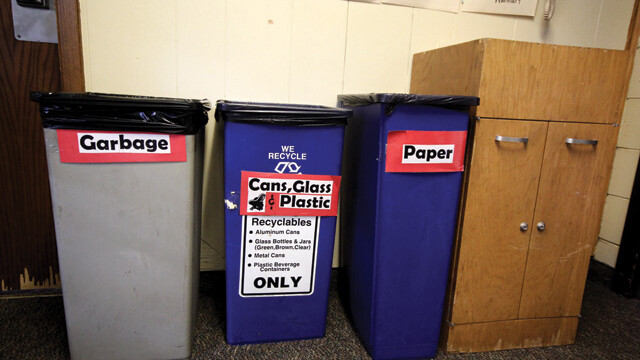Big Green On Campus
area schools are doing more and more to be environmentally conscious
V1 Staff, photos by Andrea Paulseth |

UW-Stout
Pedal Power
To promote less automobile use, UW-Stout has been sponsoring StoutBikes, a program wherein students can check out a bike for a whole year. On a first-come, first-served basis, bikes are distributed for a fee of $20 for either September to May or for summer use. In its third year StoutBikes has really taken off. “The students wanted it so we implemented it, said Sarah Rykal, Environmental Sustainability Coordinator at UW-Stout, “when we first started in 2010, we had 9 bikes that students were using. In the past year (2011-2012), we grew the program to about 40 bikes.” The program received funding through segregated student fees this year. Rykal said they anticipate more bikes and also plan to hire a student to help with maintenance.
Lights Off
UW-Stout’s green-minded students and faculty have not underestimated how much impact a simple, semi-permanent reminder can have. To hold everyone accountable for conserving energy when leaving a room (because our moms or roommates aren’t always present to harp on us), 1,500 silent-yet-stern stickers have been introduced to most buildings on campus. The stickers were designed by students in the Environmental Justice Learning Community in conjunction with faculy and staff. The manifesto “We turn LIGHTS OFF here” is printed boldly and attached smack between those switches so you can’t miss it.
Recyclemania
RecycleMania, a national recycling competition held for 8 weeks in the spring, can have a direct impact on participating campuses. Each campus records how much waste is recycled and how much is sent to the landfill. Sarah Rykal, Environmental Sustainability Coordinator at UW-Stout, says that most UW campuses participate in the competition, and the 2012-2013 school year will be UW-Stout’s sixth run. One of the most eye-opening parts of the Recyclemania completion, says Rykal is the “Trash Blitz” event. During the event, the students dive through dumpsters and reveal what recyclables were incorrectly thrown away. Well over half of campuses surveyed in any given year report a noticeable increase in recycling that is attributable to the school’s participation. This fact is supported by results which show the overall recycling rate (recycling as a percentage of waste stream) for all schools combined typically increases from the first half of the competition to the second (in 2011, the rate increased 1.42% from 24.37% to 27.79%). Participation can also benefit colleges recycling programs by bringing attention and in many cases additional resources to expand their efforts. Surveys of campus program coordinators have shown as many as 75% responding that their participation in RecycleMania drew the attention of campus administrators. As many as one quarter of respondents have credited their participation in gaining additional support to expand collection and education efforts.
CVTC
Solar Tree
Invigorated by their February success in which they installed a solar tree for Chippewa Valley Technical College, Next Step Energy hopes to release marketing strategies and solar energy packages in the next month that encourage renewable energy in urban areas throughout Eau Claire. According to Urban Designer for Next Step Joe Maurer, the tree was only a starting point. “CVTC’s tree is a prototype. As an art piece... and a learning piece for us. We’ve redesigned some elements and made it more affordable,” he says. Overall, Maurer emphasizes that the possibilities this presents are immense: “It really could be anything, the design could take on all forms... Things like street lights, bicycle racks, canopies.”
As for practical issues, solar energy doesn’t create any emissions, it doesn’t hurt the environment, and has had great results in other countries such as Germany and Spain. It’s expensive, but is increasingly shown to be cost effective. As for the actual energy, Next Step has redesigned the panel to hold 250 watts (from the original 180), and Maurer foresees them being able to scale solar power devices up to 20 kilowatts (1000 watts = 1 kilowatt). This would deliver enough to power larger pieces of equipment such as street lamps or lit bike racks.
“Every city wants to look good and do as much green as possible... and these urban designs will draw attention to the technology,” says Maurer. “We think the art is a good vehicle to talk about renewable energy.”
Center For Energy Ed.
If all goes as planned and donations come through, Chippewa Valley Technical College will be scoring some sweet new digs for the study of alternative energy sources. The proposed $7.9 million Energy Education Center would fuse a renovated Transportation Center on CVTC’s West Campus with a 30,000-square-foot addition. The center hopes to support a flurry of energy-minded studies, including biofuels, solar power, geothermal heating, and wind energy. The college’s applicable programs include heating, ventilation and air condition; civil engineering; construction; and electrical power distribution.
UW-Eau Claire
Vermicomposting
Since it’s outfitted with kitchens, Chancellors Hall is the best suited hall for feeding worms. (After the students have been fed, of course). Volunteer students collect food scraps in little white composting pails, paying close attention to the worms’ dietary restrictions. That’s right, worms have dietary restrictions – akin to a lactose intolerant (no dairy) frequent acid-refluxing (no citrus fruits) cholesterol watcher (no meats or fatty /fried foods). The contents of these pails are then combined in larger blue pails in designated recycling rooms on the second floor. The worms are able to produce nutrient- rich dark soil known as vermicompost (or worm castings) that the students offer to the Foodlums for use in their garden. A secondary product of the decomposing food scraps is nutrient rich water – worm tea – which is diluted and offered to residents to help fertilize their house plants. The program committee is funded by the Student Office of Sustainability and headed by SOS director Brittany Whited.
Centered On Green
When the Davies center opens (softly) on July 30, it will be ready for the modern world. Campus Sustainability Fellow James Boulter says that 100% of the electric energy used in the student center will come from Xcel Energy’s Windsource program. The University’s Green Fund (paid for by student fees) purchased one million kilowatt hours this year – an estimate which will have to be adjusted at the year’s end. Boulter lists off plenty of other green aspects of the building including solar hot water heaters (which will offset a large amount of water heating energy), outdoor LED lights, and tinted windows. “We made a lot of careful choices with materials,” he says. “Reclaimed wood in the interior, bamboo in the ballrooms, and low-VOC paint…” Plus, the main entryway roof will literally be green: it will host a variety of plant species, all waiting to absorb water before it runs into nearby streams and carries with it unwanted “extras” from the roads.
Taken For a Zimride
As part of a national initiative to decrease the number of commutes taken individually, the San Francisco-based online ridesharing program Zimride recently got up and running at UW-Eau Claire. Replacing the University’s previous ride board system, Zimride is easy to use and connects ride-seekers with drivers and other riders destined for the same locales. Students at several other UW system universities can access the service, too, using their University ID and password. The website automatically links with Facebook so that a picture, musical tastes, and work/school history will appear on their Zimride profile. This way, drivers can “screen” their riders and vice versa. In February 2012, Zimride had 300,000 users nationally (since their inception in 2007).





















